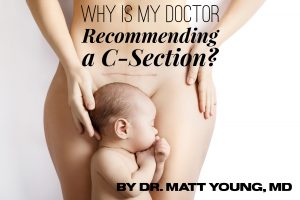Why Is My Doctor Recommending a C-Section?

By Dr. Matt Young, MD, JD, MBA, CMQ, Esq
In America, around 1 in 3 babies are born via cesarean section. We all know someone who’s had at least one, sometimes planned, and sometimes in an emergency. It’s so routine that we need to stop ourselves to remember that a C-section is major abdominal surgery. We know that C-sections save lives, but why are they so common?
Let’s Look At The Numbers
More than 30 percent of babies in America are born by C-section, but this is not consistent across every hospital. A University of Minnesota study found a 10-fold variation in C-section rates, from as low as 7 percent at one hospital to as high as 70 percent of births at another hospital. So are certain hospitals pushing for more unnecessary surgeries than others, or are women with high-risk pregnancies gravitating toward hospitals with more experience in that area? The answer is probably a little bit of both.
The World Health Organization determined that the ideal rate for C-section births should be between 10 and 15 percent to ensure the best outcomes for moms and babies. The Department of Health and Human Services has set a less ambitious goal of 23 percent of all low-risk births (the ones most likely to be medically unnecessary).
So this raises the question: Why do American doctors perform so many C-sections? If the international healthcare community has found that there’s no difference in the health of mothers or babies when more than 1 in 10 babies are delivered by C-section, does that mean that American doctors are performing unnecessary surgeries? It really depends on the particular patient and the particular clinical situation. But when a life is potentially at risk, most doctors aren’t willing to take any chances.
What May Increase My Risk For A C-Section?
While there are no hard and fast rules for when a C-section is necessary, we know that C-sections can potentially save the life of a mother and/or her baby when used judiciously. Some instances in which a C-section may be life-saving include:
While the above reasons can all make a C-section the safest option for mother and baby, numerous studies show other risk factors for a C-section, regardless of any other potential problems (or lack thereof):
Is a C-Section Dangerous?
A C-section is done to save lives (and it definitely does when used appropriately), but it’s not a risk-free procedure. Thankfully, C-sections are very safe for babies. Around 1 – 2 percent of babies are accidentally cut during the surgery, but it’s typically a minor nick that heals quickly. Recent studies show that babies born via C-section are twice as likely to develop early childhood asthma and allergies, but research is still ongoing as to whether something can be done to mitigate this risk.
There are far more serious potential risks for mothers to consider, particularly if their C-section is an elective procedure rather than necessary to save a life. Some of the most common risks include:
So What Does It All Mean?
The main takeaway from this is that vaginal birth is the safest option in a normal, healthy pregnancy. There are instances when a C-section may be necessary to save your life or your baby’s life, but it’s essential to make sure that the benefits truly outweigh the risks. While C-sections are generally considered safe, they are still a major abdominal surgical procedure and should be treated as such.
Whether your pregnancy is low or high risk, make sure to speak to your doctor about their views on C-sections and when they might recommend you have one. What percentage of their patients’ pregnancies result in a C-section delivery? Do they only perform them in situations where there is a significant risk to the health of mother or baby if delivery is delayed?
Make sure that you and your doctor agree about what would make a C-section necessary. Once you’re in the delivery room, you likely won’t have as much time or be in the right mindset to ask detailed questions. There’s no chance to carefully weigh the pros and cons when your doctor says you need a C-section now, so it’s essential to be prepared and make sure your doctor understands what you want beforehand. It’s also important to remember that C-sections in many situations are medically urgent or necessary procedures that are intended to decrease the risk of harm to mother or baby. Because these issues are often complicated and individualized, it is important to have a full conversation with your obstetrician before labor begins.
ABOUT THE AUTHOR:
Dr. Matt Young, MD, JD, MBA, CMQ, Esq., is a nationally recognized Harvard-educated attorney and physician, and patient safety advocate working for Ross Feller Casey, LLP in Philadelphia. He is board-certified by the American Board of Medical Quality (ABMQ) in medical quality, having received the designation of CMQ (Certified in Medical Quality). Dr. Young is nationally recognized in healthcare quality and patient safety and was selected as a National Quality Scholar by the American College of Medical Quality (ACMQ) for his significant work in advancing healthcare quality. He is also a peer reviewer for the Journal of Patient Safety.
Disclaimer: The views and opinions expressed in this article are those of the authors and do not (necessarily) reflect the views of PregnancyJournal.com. PregnancyJournal.com can in no way whatsoever be held responsible for the content of such views nor can it be held liable for any direct or indirect damage that may arise from such views.




